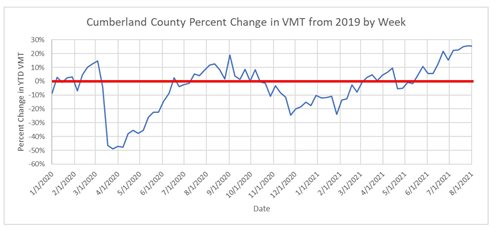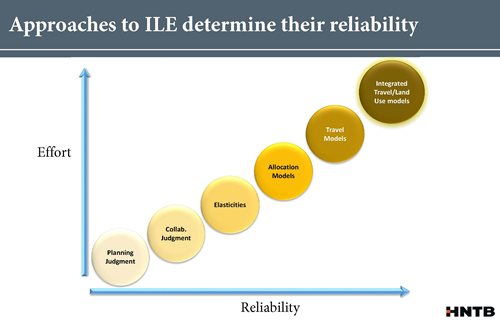1. Hasn’t COVID-19 decreased traffic in the region? Is a new road necessary?
Traffic numbers all over the state decreased in 2020 because of Covid-19 and the early April 2020 stay-at-home order. The low mark was in early April 2020, when traffic volumes on the Overlap (where Routes 22 and 114 overlap in Scarborough/Gorham) dropped to one-half of where they had been the previous year. But as of May of 2021, traffic had rebounded to near or above pre-pandemic levels in Cumberland County.
Residential growth continues strong in the region – this commuting corridor has been operating over capacity since the early 1990s.
 2. How current is the data MTA is using to for their analyses?
2. How current is the data MTA is using to for their analyses?
The 2012 Gorham East-West Study data was used as a starting point for current analyses. All traffic, economic, and environmental data has been updated as part of the Alternatives Analysis process that started in 2022 and should be completed this year.
3. Do the host municipalities support the project?
The four host municipalities (Gorham, Westbrook, South Portland, and Scarborough) are the ones asking for this project. Their select boards and councils confirmed their support again in January and February of this year with a
Memorandum of Agreement (MOA). Residents have voted to approve Comprehensive Plans that spell out what they want their communities to look like, which is less traffic-intensive and more village center-oriented. In discussion, all the communities’ economic development directors agree that a new road would take commuter and truck pressure off existing state roads, reduce commuter use of residential roads and neighborhoods, and allow safer use of downtowns by bicyclists and pedestrians.
4. How are municipalities involved?
The four municipalities most immediately affected – Gorham, Scarborough, Westbrook, and South Portland – are committed to working with MTA on the planning process for the Connector, helping to create public understanding of the project, and promoting land use strategies that are effective in making the road sustainable for the long term. All four select boards/city councils unanimously voted to approve and have signed a
Memorandum of Agreement (MOA) to that effect, as shown below.
Below is the exact language in the signed
MOA:
- appoint a representative to an Advisory Committee to guide development of the Gorham Connector
- explain publicly the benefits of the Gorham Connector as part of an integrated solution to safety and mobility needs of the region, participate in public forums and explain relevant land use goals contained in comprehensive plans
- support and explain the results and recommendations of studies and agreements, including specific transportation and land use management strategies
- cooperate with other parties to this Agreement and with those who may join as partners
- seek to preserve the effectiveness and sustainability of transportation investments by promoting compatible land use management strategies
5. Won’t a new road lead to more development?
Road projects that increase capacity raise legitimate questions about their intended and unintended effects on land use. For example, intended effects could be economic development growth and desirable land use change. Unintended effects can include sprawl-type development, occurring even some distance from the project because of the easier access.
Land use changes and growth in this region have already been occurring and are likely to continue even without improved traffic access. But to help communities better understand potential changes, MTA is planning to conduct an analysis using an integrated transportation-land use modeling approach. This analysis will determine more exactly if sprawl-type growth would occur, and if so, how much and where, giving municipalities the information they need to plan accordingly.
This information will be invaluable in helping municipalities manage and direct growth in a way that reflects community values.

6. How will the connector affect greenhouse gas emissions? VMT? VHT? How does the project consider Maine Won’t Wait climate goals?
For all alternatives – including doing nothing (No Build) and widening the existing roads (Widen Roadway Alternatives) – carbon dioxide emissions (CO2e), greenhouse gas (GHG) emissions, and volatile organic compounds (VOC) were modeled for 1) existing 2023 conditions, 2) projected opening year (2030), and 3) design year (2050) conditions. The modeling used EPA’s MOVES3, a transportation industry standard. Updated analysis is ongoing and results will be available soon.
7. How does transit factor into MTA decisions? Are there logical transit connections? New Park and Ride lots?
MTA has no jurisdiction over transit. However, using the new road for bus transit and adding new Park and Ride lots will likely be part of the community discussion. The project is not taking place in a vacuum; other regional transit studies have been completed (Transit Tomorrow, Transit Together, Maine Mall Transit-Oriented Development) or are underway (Gorham Westbrook Portland Rapid Transit Study) that will contribute to understanding how to fold the road into the region’s goal of expanding transit.
8. Why is the MTA purchasing land for this project now?
Development pressures are strong in this region, and MTA is talking with landowners now about purchasing select parcels of land in order to keep options open for a new road. Once land is developed into residential or commercial uses, it is more expensive – and sometimes impossible – to purchase land for a new road corridor without disrupting existing development. Purchasing properties now means that a viable route will be available should the decision be made to build. Should the decision go the other way, MTA would simply sell the land on the open market.